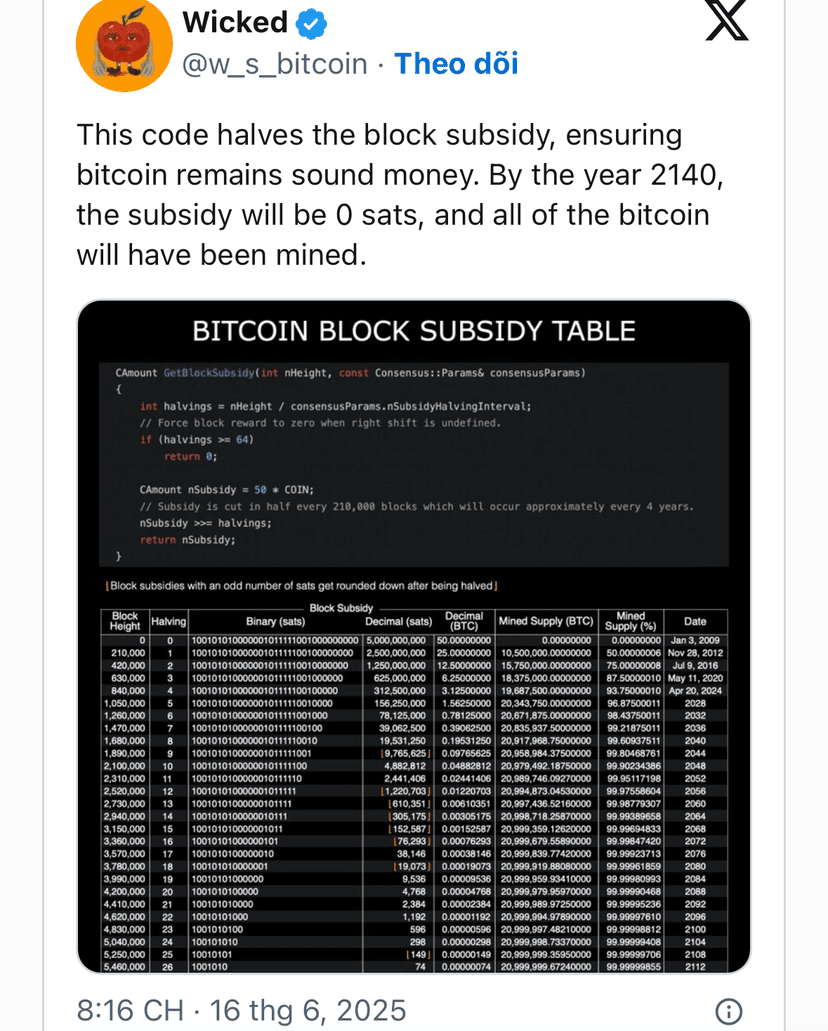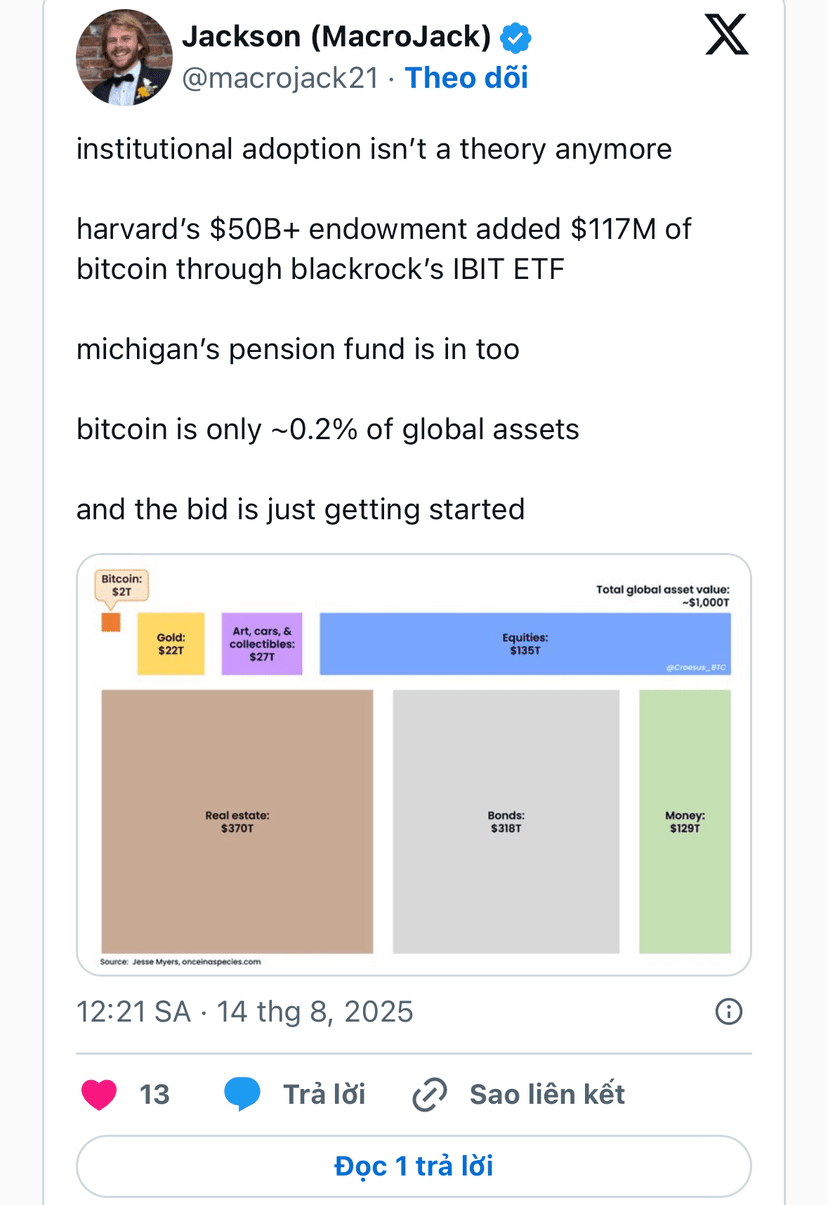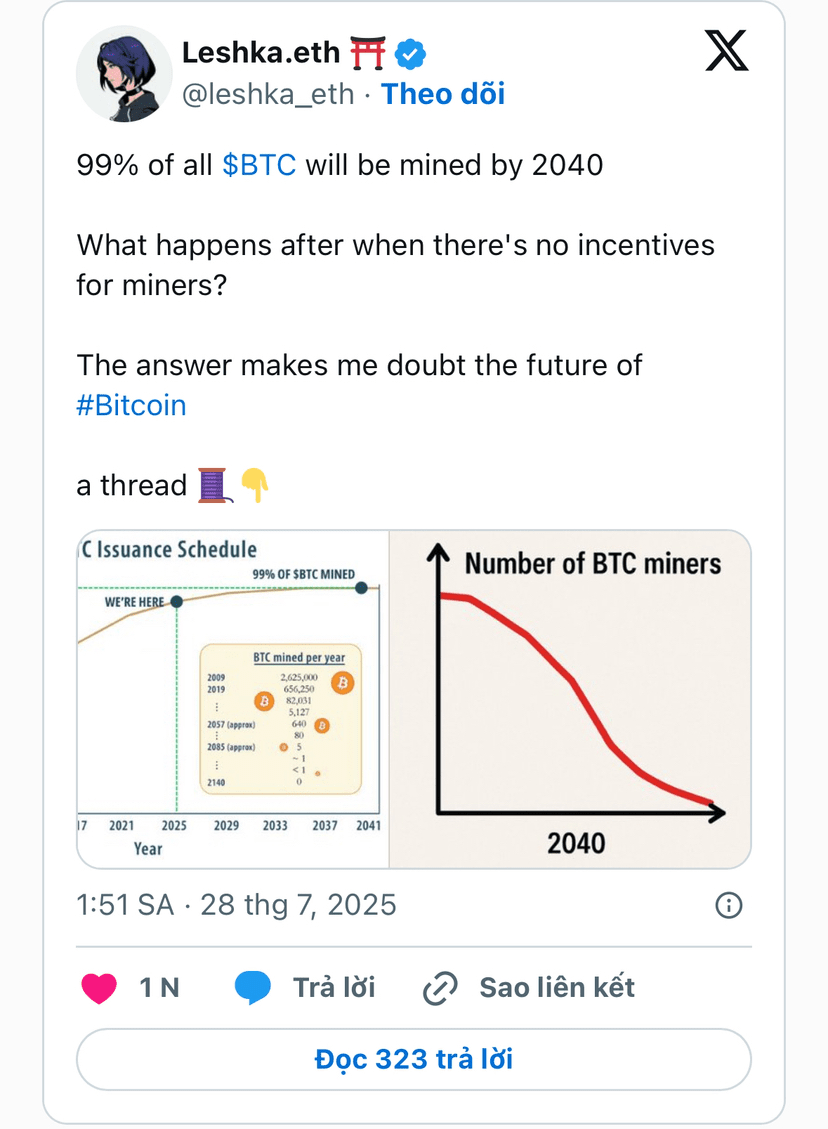By 2140, all 21 million Bitcoins in the world will have been mined, marking a significant turning point in the history of cryptocurrency. At that point, the majority of miners' income will vanish, and maintaining network security will entirely depend on transaction fees.
Experts from OKX Singapore, JuCoin, and XBO believe this timeline is still far off, allowing the Bitcoin community ample time to prepare. It is expected that demand from both large institutions and retail users will be strong enough to justify high transaction fees, ensuring security for the network. However, experts also warn of potential challenges regarding centralization and the adaptability of the system.
Challenge 2140: Post-subsidy Bitcoin
For over a century, the block subsidy has been the "key" to securing the Bitcoin network. This reward is paid to miners when they validate transactions and create new Bitcoins, serving as both an incentive and a mechanism to keep the network decentralized and secure.

However, by 2140, Bitcoin will ultimately be mined, meaning the block subsidy will completely disappear.
"When the final block reward disappears, the entire security of the Bitcoin network will rely solely on transaction fees. The key issue at that point is how demand for block space will grow," shared Gracie Lin, CEO of OKX Singapore.
Experts believe that if demand for Bitcoin continues to rise as it currently is, the source of transaction fees could naturally fill the gap, ensuring network security without the need for block subsidies.
Price increase potential: The optimistic scenario
The increasing utility of Bitcoin, driven by rising demand and large value transactions, could naturally create a strong fee market capable of maintaining network security over time. Along with the continuous development of the Bitcoin ecosystem, transaction fees may sustainably increase.
"By 2140, Bitcoin could become an essential digital infrastructure in the global finance system. Large value transactions will naturally generate significant fees. It's like premium real estate; when an asset is scarce and important, people are willing to pay a price," said Sammi Li, Co-founder and CEO of JuCoin.
Confidence in this scenario is based on the increasingly deep involvement of large organizations. As organizations integrate Bitcoin into their business operations, they will create stable demand for on-chain transactions and become a reliable revenue source for miners.

Large-scale transactions from these entities will be key to a healthy fee market, legitimizing and ensuring long-term stability.
"The treasury's money transfer activities, cross-border payments, and large Layer 2 transactions will drive regular demand. The adoption of Bitcoin by businesses and central bank digital currencies will create a stream of high-value, stable transactions, offsetting high fees," Li added.
Additionally, the supporting infrastructure for the network will also develop naturally. Future Layer 2 solutions will become crucial in ensuring Bitcoin's long-term sustainability.
Layer 2 elevates the Bitcoin network
Layer 2 protocols, most notably the Lightning Network, have been developed to address Bitcoin's scalability limitations. By handling small and frequent transactions off the main blockchain, these solutions help reduce congestion, lower transaction fees, and maintain efficiency for daily operations.
"Layer 2 plays a crucial role. It not only expands everyday usability but also keeps the main Bitcoin chain neat and valuable. Thanks to user-friendly gateways, the Lightning Network and similar improvements make Bitcoin viable for both micro and macro transactions. Meanwhile, centralized exchanges continue to attract new users and increase liquidity for the ecosystem," said Lior Aizik, CEO of XBO.
In fact, these Layer 2 solutions stimulate traffic back to the main chain rather than diminish its value.
"Layer 2 truly creates a lot of valuable activity back to the main chain. Lightning channels need to be opened and closed on the blockchain, and new solutions are opening entirely new types of high-value transactions," Li explained.
However, this process still carries risks. The success of Layer 2 depends on its ability to generate enough transaction fee volume to sustain Bitcoin's network security in the long run.
Does the fee model undermine Bitcoin's security?
While many believe that the long-term utility of Bitcoin will help maintain network security even after the block subsidy ends, some experts warn that the transition to a model entirely based on transaction fees is not without its risks. In fact, maintaining long-term security could face significant challenges.
If transaction fees do not grow steadily with usage demand, the financial incentive for miners may decrease. When rewards decrease and fees do not adequately compensate, a number of miners may withdraw from the network, leading to a decrease in hashrate. This will weaken the resilience and attack resistance of the Bitcoin network, creating risks for the entire ecosystem.

"Bitcoin's security budget will gradually erode over time, reducing the incentive for network security. In a worst-case scenario, a significant portion of mining capacity – possibly up to 20-30% – could cease operations, similar to previous hashrate shocks due to declining mining profits or regulatory changes," Lin stated.
Moreover, the unstable volatility of transaction fees also poses a threat to Bitcoin's decentralization. Small miners, who find it difficult to sustain operational costs when profits are low, may withdraw. At that point, the network risks becoming more centralized around a few large miners or mining organizations, undermining the core principle that Bitcoin was built on: decentralization and resistance to centralized control.
Thus, although the fee model is a necessary step for Bitcoin to operate sustainably after 2140, ensuring it does not undermine security and decentralization will be a significant challenge that the community and developers must address early.
Will Bitcoin be able to maintain its promise of decentralization?
Decentralization is one of the core principles that make Bitcoin a secure and reliable network. However, if the transaction fee market becomes unpredictable, mining power (hashrate) could become concentrated among a few miners or large organizations, directly threatening this principle.
"If transaction fees are insufficient to support small independent miners, the Bitcoin network risks becoming more centralized – undermining one of its fundamental principles," Aizik said.
The failure of the fee model not only affects the security of the network but could also lead to serious consequences for the role of Bitcoin in the global economy. If the network loses its stable operational function, Bitcoin's reputation as a reliable store of value will also suffer, causing investors and businesses to lose trust.
"There is a risk that Bitcoin could become more of a display item in a museum than a living ecosystem, with limited ability to transact and circulate," Aizik cautioned.
Fortunately, the Bitcoin community still has over a century—around 115 years—to plan, experiment, and prepare solutions to protect decentralization, ensuring that the network continues to operate smoothly even when the block subsidy model ends.
Planning ahead
Despite the potential risks associated with the fee model and the ability to maintain decentralization, Bitcoin industry leaders remain very optimistic about the network's future. They agree that Bitcoin's inherent design, coupled with a dedicated community and a thriving ecosystem, will allow the network to successfully transition to a model entirely based on transaction fees without compromising security or value.
"The securities pricing market operates extremely efficiently when the risk is significant enough. If Bitcoin maintains its value by 2140, economic factors will self-adjust to protect that value. The long transition period allows the community to gradually adapt, avoiding sudden shocks and maintaining network stability," Li remarked.
Aizik agreed and emphasized that the early discussion of this model shows its feasibility. He noted:
"The industry needs dedicated organizations to participate in this development process – both to support the next generation of users and to respect Bitcoin's core principles."
By continuing to foster a forward-looking spirit and responsible community participation, the future of Bitcoin will be in the hands of reputable individuals ready to protect, operate, and develop the network, ensuring that Bitcoin remains a decentralized and reliable financial infrastructure for many decades to come.